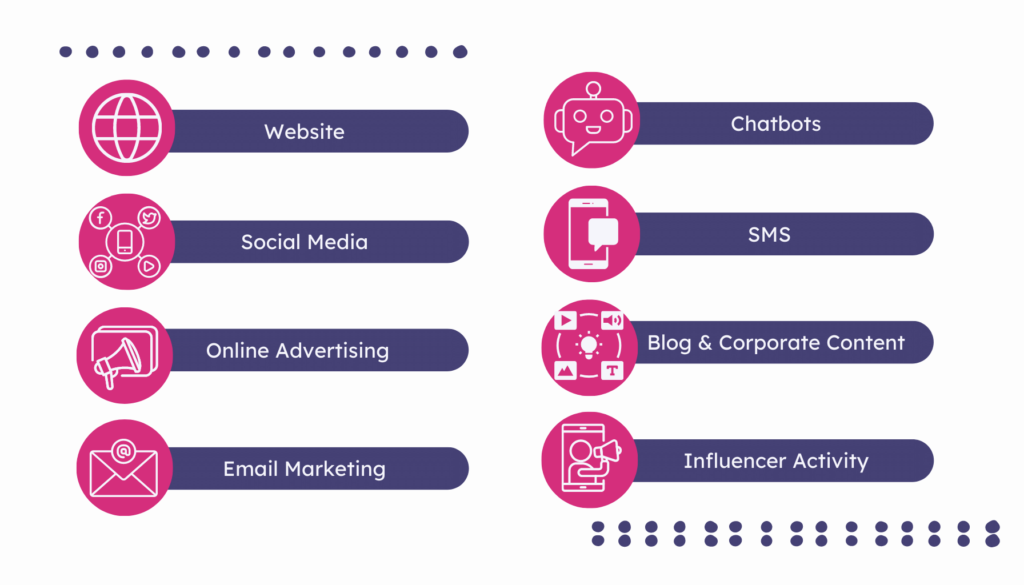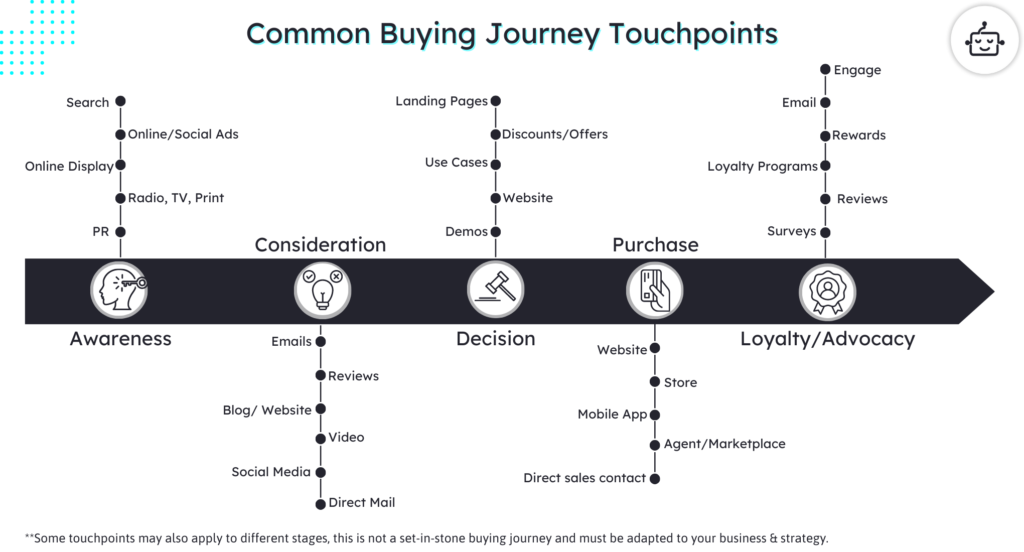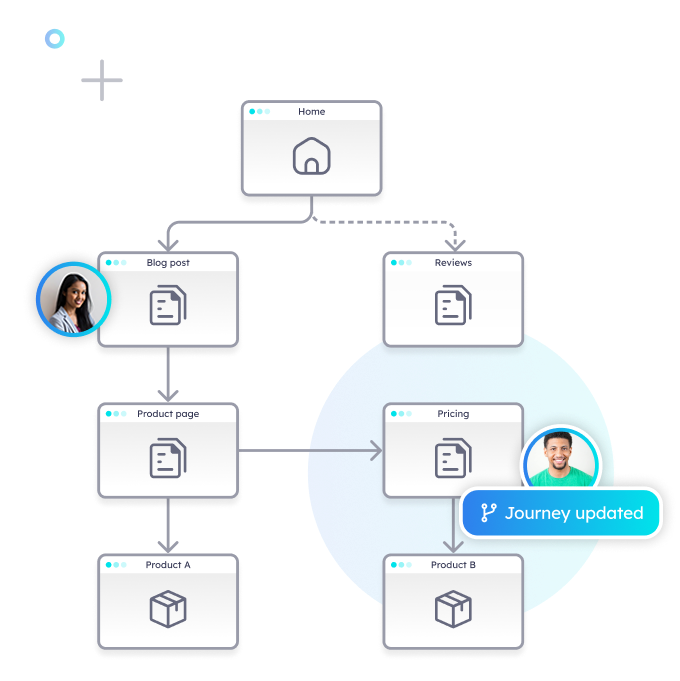With the rise of various marketing channels, it’s essential to understand the concept of touchpoints and how they can affect your marketing efforts. Touchpoints refer to any point of contact between your brand and your customers or prospects. These touchpoints can be online or offline and can play a significant role in building brand awareness, creating a positive customer experience, influencing purchase decisions, and encouraging customer loyalty.
Understanding touchpoints will allow you to optimize your marketing strategies by focusing on the most impactful touchpoints. By mapping out the customer journey and identifying key touchpoints, you can create a more personalized and consistent experience for your customers. This can lead to increased engagement, higher conversion rates, and more loyal customers.
We’ll delve deeper into the concept of touchpoints and explore different types of touchpoints, including online and offline. We’ll also discuss why touchpoints are essential in marketing and provide tips on how to optimize touchpoints for marketing success. You’ll have a better understanding of touchpoints and how they can help you achieve your marketing goals.
Types of Touchpoints
Online Touchpoints
- Website:
Your website is often the first point of contact between your brand and potential customers. It serves as a hub of information about your products or services, and it’s where customers can make purchases or contact you. Your website should be optimized to provide a seamless user experience, with clear navigation, fast loading times, and engaging content. Examples of touchpoints on your website include the homepage, product pages, checkout pages, and contact forms. These touchpoints will provide your prospects with the information they need to make an informed decision, ultimately giving you the opportunity to leverage touchpoints to influence purchase decisions.
- Hyper-Personalized Micro-Experiences
This real-time personalization is instantly delivering contextually relevant content to each website visitor in relation to their responses and actions with your website and brand. This touchpoint is giving you the power to effectively influence a buyer’s decision based on their intent. These hyper-personalized micro-experiences allow you to offer value in key-decision moments while ensuring visitors remain engaged. With content that is tailored to the needs of the buyer, your prospects feel catered to and supported.
Pathmonk delivers micro-experiences that match the stage of the buying journey to trigger more conversions. Delivering appropriate moments to match the stage of a prospect, while ultimately anticipating their questions and showing the right content, allows for dynamic, predictive, and real-time personalization.
- Social Media:
Social media platforms are a powerful tool for building brand awareness and engaging with customers. It’s an opportunity to show more of the personable side of the brand and create more meaningful connections. They offer a range of touchpoints, from posts and stories to comments and direct messages. Each social media platform has its own strengths and weaknesses, so it’s important to tailor your content to each platform and its audience. For example, Instagram is great for visual content, while Twitter is ideal for short, snappy messages. These touchpoints can be used to increase engagement, encourage user-generated content, and drive traffic to your website.
- Online Advertising:
Online advertising can take many forms, including display ads, search ads, and social media ads. These touchpoints are designed to target specific audiences and drive traffic to your website or landing page. As you’re showcasing your products or services in a visually appealing way, they can be particularly effective at influencing purchase decisions.
- Email Marketing:
Email marketing is a cost-effective way to reach customers directly and build relationships with them over time. Touchpoints in email marketing include the subject line, email content, and calls to action. By personalizing your emails and providing relevant content, you can increase open rates, click-through rates, and conversions.

- Chatbots:
Chatbots are a great way to provide 24/7 customer support and engage with customers in real time. Touchpoints with chatbots include the initial greeting, conversation flow, and resolution of customer issues. They can be used to provide quick answers to customer questions, recommend products, and offer personalized discounts.
- SMS:
What do we always have in our hands? Cellphones. SMS marketing gives you the power to reach customers directly on their mobile devices. Touchpoints in SMS marketing include the message content, call to action, and landing page. This touchpoint can be used to offer exclusive promotions, notify customers of new products, and provide personalized recommendations.
- Blog and Corporate Content:
Blogs and other types of corporate content, such as whitepapers and case studies, are touchpoints that can be used to provide valuable information to customers. By providing educational content, you can position your brand as an authority in your industry and build trust with your audience.
- Influencer Activity:
Influencer marketing involves partnering with social media influencers to promote your brand. It’s very effective to reach new audiences, increase brand awareness, and drive traffic to your website.
These online touchpoints can be found throughout the customer journey, from the awareness stage to the post-purchase stage. For example, a customer may first become aware of your brand through a social media ad or influencer post, then visit your website to learn more about your products or services. They may then sign up for your email list, receive personalized recommendations through SMS, and ultimately make a purchase. By optimizing each touchpoint along the way, you can provide a seamless and enjoyable experience for your customers, increasing their satisfaction and loyalty to your brand.
Offline Touchpoints
- Print Media
Print media is a tried-and-true method of marketing that involves the use of printed materials to reach customers. This can include newspapers, magazines, flyers, brochures, and posters. Print media is an effective way to increase brand awareness, educate customers about your products or services, and drive sales.
- Events and Conferences
Events and conferences provide an opportunity to showcase your brand in a physical setting, allowing customers to interact with your products or services directly, and speak directly to you! Touchpoints at events and conferences can include booth design, promotional materials, product demonstrations, and in-person conversations. By creating an engaging and memorable experience, you can leave a lasting impression on potential customers.
- Phone Calls
Phone calls involve directly contacting potential or existing customers to provide them with information about your product or service. Phone calls can be used to build relationships with customers, gather feedback, and drive sales. Don’t underestimate the power of a simple phone call millennials.
- In-Person Meetings
In-person meetings involve meeting with potential or existing customers in person to provide them with information about your product or service. In-person meetings can be used to build relationships with customers, gather feedback, and drive sales.
- Merchandising
Merchandising involves using branded items such as t-shirts, tote bags, and keychains to promote your brand. Merchandising can be used to increase brand awareness, promote customer loyalty, and drive sales. ‘Hey, that’s a really cool hoodie! What company is that?’ ‘Oh, it’s Pathmonk, you should check them out’
- Outdoor Advertising
Outdoor advertising involves using billboards, bus stop ads, and other outdoor signage to promote your brand. Outdoor advertising can be used to increase brand awareness and reach a large audience. Think about the number of times you use public transportation and the subliminal messages surrounding you from posters to billboards. Classic advertising can still go a long way.

Touchpoints in the Customer Journey
Understanding how touchpoints are distributed throughout the customer journey is essential for developing an effective marketing strategy that meets the needs of potential customers.
The customer journey typically consists of three stages: awareness, consideration, and decision. In the awareness stage, customers are becoming familiar with a brand and its products or services. Common touchpoints in this stage include online advertising, social media, and outdoor advertising. Online advertising can include search engine ads, display ads, and video ads, while social media can include organic posts, sponsored posts, and influencer marketing. Outdoor advertising can include billboards, bus stop ads, and other forms of signage.
In the consideration stage, customers are actively researching and evaluating their options. Common touchpoints in this stage include website content, email marketing, and in-person meetings. Website content can include product descriptions, reviews, and comparison guides, while email marketing can include newsletters, promotions, and personalized recommendations. In-person meetings can include sales consultations, product demonstrations, and events.
In the decision stage, customers are ready to make a purchase. Common touchpoints in this stage include phone calls, in-person meetings, and checkout processes. Phone calls can include sales calls, customer support calls, and follow-up calls. In-person meetings can include final product demonstrations or meetings with decision-makers. Checkout processes can include online purchases, subscriptions, or in-store purchases.
Each touchpoint plays a unique role in shaping the customer’s perception of the brand and their decision-making process. Touchpoints in one stage can also help to boost the effectiveness of touchpoints in other stages. For example, online advertising can help to increase brand awareness and make customers more receptive to website content or in-person meetings. In-person meetings can help to build trust and provide personalized information that encourages customers to make a purchase.
A comprehensive understanding of the customer journey and touchpoints can also help businesses identify gaps in their marketing strategy and optimize their touchpoints to meet the needs of potential customers.
Understand your customer journey analytics
See how your users behave, find drop-offs, and receive actionable insights with AI.

Pathmonk Intelligence is a powerful tool for marketers looking to optimize their touchpoint strategies. By analyzing customer behavior and interactions with touchpoints throughout the customer journey, Pathmonk Intelligence provides valuable insights into how touchpoints interact and impact the overall customer experience. This allows marketers to identify areas for improvement and make data-driven decisions to optimize the journey for maximum impact and get up to 10x more conversions.
How to Optimize Touchpoints for Marketing Success
Optimizing touchpoints is crucial for marketing success. In order to effectively optimize touchpoints, it is important to map out the customer journey, identify key touchpoints, maintain consistency across touchpoints, personalize the customer experience, and measure touchpoint effectiveness. By following these steps, businesses can create a more engaging and effective marketing strategy.
- Mapping out the Customer Journey
Mapping out the customer journey involves identifying the stages of the journey and the touchpoints that are associated with each stage. This process can help you understand how customers interact with your brand and identify areas for improvement. To map out the customer journey, you can use a variety of tools, such as customer journey maps, flowcharts, and decision trees. Or templates we generously provide you with!
Free template: customer journey touchpoints
Map your marketing touchpoints and understand your users' journey to conversion across all stages

- Identifying Key Touchpoints
Identifying key touchpoints involves understanding which touchpoints are most critical to the customer journey and the overall customer experience. Key touchpoints may vary depending on the industry, target audience, and specific business goals. To identify key touchpoints, analyze customer data, conduct customer surveys, and engage in competitive analysis.
- Consistency Across Touchpoints
Consistency across touchpoints is essential for creating a seamless and engaging customer experience. Consistency involves maintaining a consistent brand voice, visual identity, and messaging across all touchpoints. This can help to build brand recognition and trust and ensure that customers have a clear understanding of the brand and its offerings.
- Hyper-Personalization
Hyper-personalization involves tailoring the customer experience to the individual customer’s needs and preferences. This can be achieved through a variety of methods, such as personalized emails, product recommendations, and targeted advertising. Personalization can help to build customer loyalty and increase the likelihood of a purchase.
- Measuring Touchpoint Effectiveness
Measuring touchpoint effectiveness involves analyzing customer data to understand how customers interact with each touchpoint and how each touchpoint contributes to the overall customer journey. This can be achieved through a variety of methods, such as website analytics, customer surveys, and social media monitoring. By measuring touchpoint effectiveness, you can identify areas for improvement and optimize your touchpoints to better meet the needs of your customers.
Conclusion
Touchpoints are crucial in creating an effective marketing strategy. They give you an opportunity to connect with customers and build lasting relationships in a world that often feels disconnected. By understanding the types of touchpoints, in both the online and offline worlds, you can create a seamless customer journey that maximizes engagement and ultimately drives conversions.
Remember in order to optimize your touchpoints for marketing success, you should start by mapping out the customer journey and identifying key touchpoints. Consistency is key across all touchpoints, it means that you maintain brand identity and create a cohesive experience for the customer. Personalization is about taking your touchpoints to another level as you tailor your approach to each individual customer and enhance that overall user experience. Finally, you can’t change what you don’t measure. Measuring touchpoint effectiveness through metrics and analytics is essential to continually improve and refine the marketing strategy.
By focusing on these key elements, you’ll be sure to leverage touchpoints effectively to reach your marketing goals!








